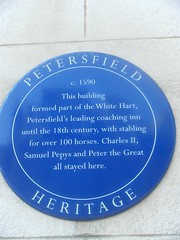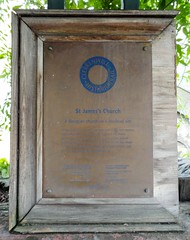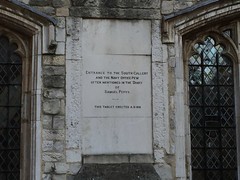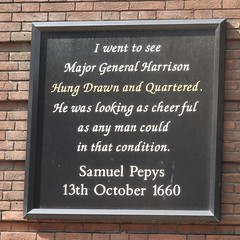Samuel Pepys PRS


Samuel Pepys PRS
(1633-1703)
diarist, Secretary of the Admiralty, Member of Parliament (1673-1679), 6th President of the Royal Society (1684-1686), and Member of Parliament (1685-1689)
Family tree
Commemorated on 18 plaques
In a house formerly standing on this site lived Samuel Pepys 1633-1703 diarist and Robert Harley, Earl of Oxford 1661-1724 statesman and in this house lived William Etty 1787-1849 painter and Clarkson Stanfield 1793-1867 painter
14 Buckingham Street, Westminster, WC2, London, United Kingdom where they lived
Samuel Pepys 1633-1703 Diarist and Secretary of the Admiralty lived here 1679-1688
12 Buckingham Street, London, United Kingdom where they lived (1678-1687)
In a house on this site Samuel Pepys, diarist, was born. 1632-1703
Salisbury Court, London, United Kingdom where they was born (1633)
Samuel Pepys Diarist 1633-1703 "...lay at The Hart a good house and there a fair and pretty town..." on 15th-16th June 1668 Parts of the inn's galleries remain in nearby buildings.
114 High Street, Marlborough, United Kingdom where they stayed
Site of the Navy Office in which Samuel Pepys Lived and Worked Destroyed by Fire 1673
Seething Lane, EC3, London, United Kingdom where they lived and worked
Old George Hotel The Great Hall is thought to date from the reign of Edward II but the facade is largely 15th Century with later bay windows. The Inn is first mentioned in 1378 and was bought in 1414 by The City Corporation who owned it until 1863 when the licence lapsed. Samuel Pepys stayed here in 1668 and at that time plays were acted in the yard and the Free School was held here. The ground floor was removed and a new steel frame inserted in 1967 by the Hammerson Group of Companies as part of The Old George Mall Shopping Centre to which the new Arcade now forms the main entrance. The post on which this plaque is fixed was hand carved by a local craftsman to match the other which is original. The Granite Setts which are recessed into the paving, mark the position of the original timber posts.
entrance to the Old George Mall shopping centre from the High Street, Salisbury, United Kingdom where they stayed
On this site was built the Davies Amphitheatre 1662-1682 the last bear-baiting ring of Bankside visited by Samuel Pepys and John Evelyn. To the north from mid 16th century was the Bear Gardens, a bear-baiting ring visited by Queen Elizabeth I and replaced by The Hope Playhouse 1614-1656, built for plays and bear-baiting where Ben Jonson's play 'Bartholomew Fair' was first performed
Bear Gardens, SE1, London, United Kingdom where they visited
c. 1580 This building formed part of The White Hart, Petersfield's leading coaching inn until the 18th century, with stabling for over 100 horses. Charles II, Samuel Pepys and Peter the Great all stayed here.
Winton House, High Street, Petersfield, United Kingdom where they stayed
The Swan Hotel. On this comer site stood The Swan Hotel, an ancient coaching inn reputed to have been visited by Samuel Pepys. The building burned down in The Great Fire of Biggleswade in 1785, was subsequently rebuilt to become the principal hotel in the town. Demolished in 1973.
Pegasus House, High Street , Biggleswade, United Kingdom where they reputedly stayed
St James's Church. A Georgian church on a medieval site. St. Mary's Nunnery church was built here in the 12th century. Henry VIII closed the nunnery in 1539, but the church continued as Clerkenwell parish church. Diarist Samuel Pepys came here to look at the local beauties. It was rebuilt in 1792 to the designs of James Carr, a local architect, and has a fine organ by George England Pike.
St James Church, Clerkenwell Close, London, United Kingdom where they visited
The Old Bell Inn. Pepys Stayed here in 1669
Gabriels Hill, Maidstone, United Kingdom where they stayed
The Grange. Formerly the Swann Inn, this building held pride of place among Stevenage inns. Samuel Pepys stayed here in 1667 and it was reputed to be the first stop for couples from London, on their way north to Gretna Green.
5 High Street, Stevenage, United Kingdom where they stayed (1666)
Near this spot Punch's Puppet Show was first performed in England and witnessed by Samuel Pepys 1662
St Paul’s Church, Covent Garden, WC2, London, United Kingdom where they was
In this house lived Samuel Pepys Born 1633 Died 1703
Cadbury World - Bull Street, Birmingham, United Kingdom where they lived
On this side once stood Impington Hall c. 1590 - c. 1952 Originally built for John Pepys, the house remained in family hands until 1864. Samuel Pepys, the diarist, was a frequent visitor. Histon and Impington Village Society 30th Anniversary 2009
Percheron Close, Cambridge, United Kingdom where they visited
Entrance to the South Gallery and the Navy Office Pew often mentioned in the diary of Samuel Pepys
, London, United Kingdom where they was
Pink Plaque Project #P
Nell Gwynn 1650-1687 Prolific celebrity actress of the Restoration period, one of the first on the English stage, and praised by Samuel Pepys as 'pretty witty Nell'. Best known as a mistress of Charles II, she had two sons by him. Charles (Created Earl of Burford and later Duke of St Albans) and James Beauclerk. She briefly lived at Lauderdale House
Lauderdale House, Highgate Hill, Highgate, London, United Kingdom where they was
I went to see Major General Harrison Hung Drawn and Quartered. He was looking as cheerful as any man could in that condition. Samuel Pepys 13th October 1660
Great Tower Street, London, United Kingdom where they was















